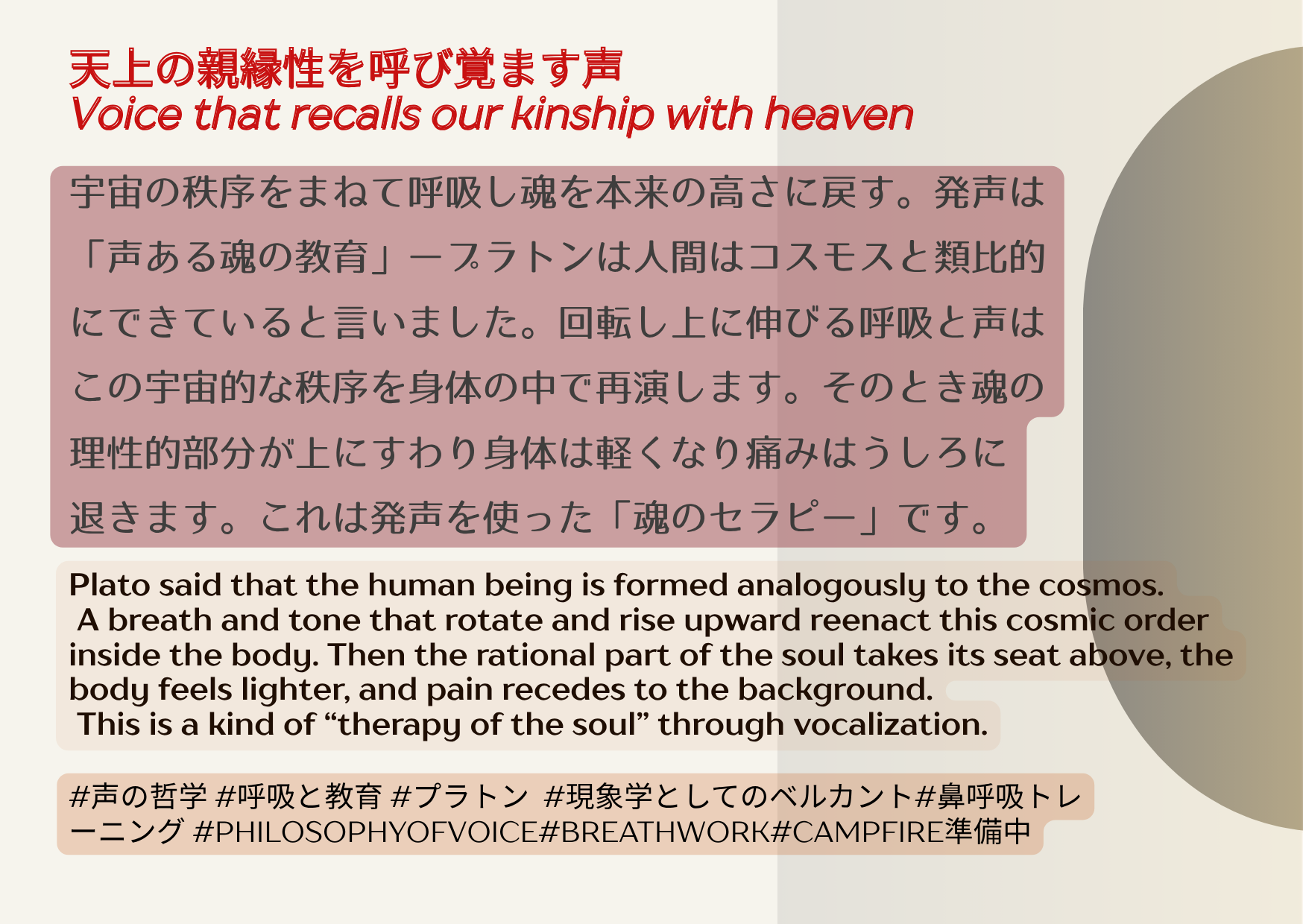1. はじめに
プラトン『テイマイオス』は、人間を単なる肉体的存在としてではなく、宇宙と親縁性をもつ「ミクロコスモス」としてとらえる。
私はこの視点が、発声と呼吸を中心におく南欧的な唱法を説明するうえで非常に有効だと感じている。
本稿では、テイマイオスの人間観を手がかりに、呼吸と声がどのようにして魂を本来の秩序へと戻す“セラピー”になりうるかを示す。
2. テイマイオスにおける人間と宇宙の類比
- 人間は身体と魂から成るが、本質は魂にあるとされる。
- 宇宙もまた身体と魂を備えた一つの生命体であり、人間はこの宇宙の範型を見て形づくられた。
- したがって人間は、宇宙の秩序・数・比例を理解し、それに似ることで自分自身を整えることができる。
3. 魂の病とその治療としての自然哲学
プラトンは、魂にも病があり、それは無知と狂気のかたちで現れるとした。
治療には、魂のもともとの性質を回復させることが必要であり、その方法として「宇宙の精神的構造を認識し、それを模倣すること」が挙げられる。
自然哲学が倫理学の一部とされるのはこのためである。
秩序だった宇宙を知ることで、魂の理性的部分が他の部分(気概・欲望)を統御できるようになる。
4. 発声呼吸による宇宙秩序の再演
ここで発声呼吸が具体性を与える。宇宙が回転・比例・上昇という秩序をもつならば、声もまた回転し、一本の呼吸柱で上方へと抜けていくとき、身体内部に同型の運動が生じる。
これにより注意は上位に集まり、理性的部分が「頭(かしら)」として位置づけられ、身体的感覚は軽くなる。
この瞬間、歌い手はまるで「天上の植物」として上へ引かれているように感じる。
5. 主観的経験としての「浮揚」と「伸展」
コロラトゥーラを歌っているときに身体が浮くように感じられ、関節が伸び、身体が大きく感じられるという体験は、魂が上方にすわり直し、身体がそれに従属したときの感覚的表現である。
痛みがうしろへ退くのも同様に、感覚の主導権が下位から上位へ移った結果として説明できる。
6. 魂は「長生きエリア」であるという翻訳
肉体は時間的にも空間的にも制限があるが、魂は天との親縁性をもち、より長いスパンで存続する“長生きエリア”として理解できる。
発声呼吸は、注意とエネルギーをこの長生きエリアへ移行させる操作であり、プラトン的な「死こそ妨げなき探究の始まり」という視点とも響き合う。
7. 結論
以上より、『テイマイオス』の人間学は、発声を単なる技術ではなく「魂の世話」として位置づける枠組みを与えてくれる。
宇宙の秩序を声で再演すること――これがベルカント的発声の根底にある教育的意味であり、まさに「声ある魂の教育」と呼ぶにふさわしい。
Timaean Cosmology and Vocal-Breathing as an “Education of the Ensouled Voice”
1. Introduction
Plato’s Timaeus does not treat the human being as a merely bodily creature, but as a “microcosm” that shares kinship with the ordered universe.
I find this perspective especially useful for explaining a vocal and breathing practice rooted in the Southern/Bel Canto tradition.
In what follows, I will use the Timaean view of the human being to show how breathing and vocalization can become a “therapy” that restores the soul to its original order.
2. Analogy between the human being and the cosmos in the Timaeus
- The human being consists of body and soul, but its essence is in the soul.
- The cosmos, too, is a living being that possesses both body and soul; and the human being was shaped while gazing at this cosmic paradigm.
- Therefore the human being can understand the numbers, proportions, and order of the cosmos and, by resembling them, reorder itself.
3. Diseases of the soul and natural philosophy as therapy
Plato holds that the soul can also become diseased, appearing as ignorance and madness.
To heal it, the soul must be restored to its original nature. The way to do this is to know the intelligible, structured order of the universe and to imitate it.
This is why natural philosophy becomes part of ethics: by knowing the ordered cosmos, the rational part of the soul becomes able to govern the spirited and appetitive parts.
4. Reenacting cosmic order through vocal-breathing
Here vocal-breathing gives the idea a concrete form.
If the cosmos has an order of rotation, proportion, and upward tendency, then a voice that rotates, is carried by a single vertical breath-column, and exits upward causes the same kind of movement inside the performer.
Attention gathers upward; the rational part takes its place as “head”; bodily sensations become lighter. In that moment, the singer feels as if she were a “heavenly plant” being drawn upward.
5. Subjective experience of “levitation” and “extension”
When singing coloratura passages, one may feel as if the body were floating, the joints were extending, and the whole body were becoming larger.
This can be described as the sensory expression of the soul’s re-seating itself above and the body submitting to it.
The fact that pain recedes into the background can likewise be explained as the shift of sensory dominance from the lower to the higher part.
6. Translating this as the soul being a “long-life area”
The body is limited in time and space, but the soul maintains kinship with the heavenly and can be understood as a “long-life area.
” Vocal-breathing is the operation that shifts attention and energy from the limited area to this long-life area.
In this sense it resonates with Plato’s view that “death is the beginning of an inquiry unhindered by the body.”
7. Conclusion
Thus, the anthropology of the Timaeus provides a framework for positioning vocalization not merely as a technique but as a form of “care of the soul.
” To reenact the cosmic order by means of the voice—this is the educational meaning at the root of Bel Canto vocalization, and it is precisely what may be called an “education of the ensouled voice.”
In bel canto practice, the rotating, upward-carrying breath becomes a small-scale performance of the cosmic order, so the voice works not only aesthetically but therapeutically on the soul.

